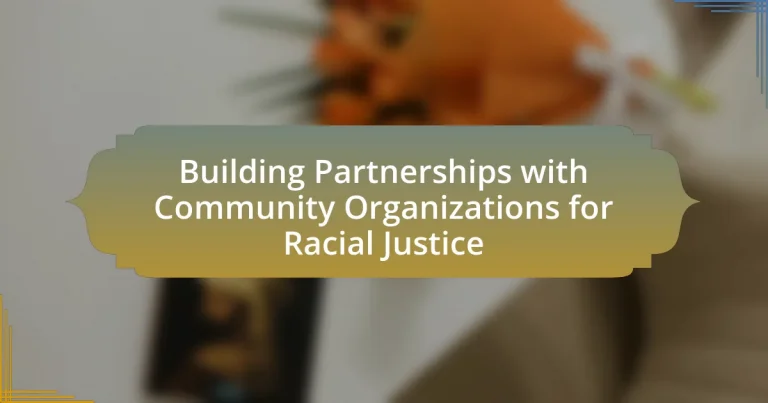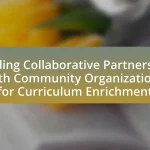Building partnerships with community organizations for racial justice involves collaborative efforts to address systemic inequalities and promote equity within communities. The article outlines the roles of community organizations in mobilizing support, advocating for policy changes, and providing resources to marginalized groups. It emphasizes the importance of collaboration in enhancing the effectiveness of racial justice initiatives, detailing strategies for building successful partnerships, addressing potential conflicts, and measuring impact. Key elements such as clear communication, mutual respect, and shared goals are highlighted as essential for fostering sustainable outcomes in racial justice efforts.
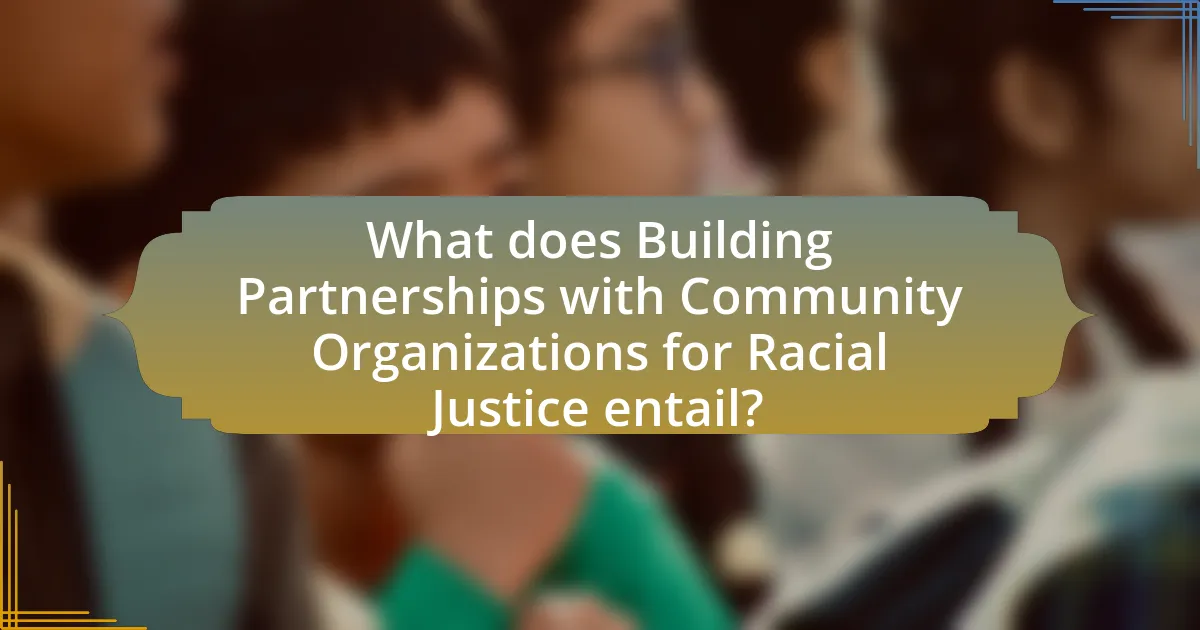
What does Building Partnerships with Community Organizations for Racial Justice entail?
Building partnerships with community organizations for racial justice entails collaborative efforts aimed at addressing systemic inequalities and promoting equity within communities. These partnerships involve engaging local organizations that represent marginalized groups, sharing resources, and co-developing initiatives that target specific racial justice issues. For instance, studies have shown that community-led efforts, such as those documented in the “Community-Centric Racial Justice Framework” by the Race Forward organization, demonstrate that inclusive collaboration leads to more effective advocacy and policy change. This approach not only amplifies the voices of those directly affected by racial injustices but also fosters sustainable solutions through shared knowledge and collective action.
How do community organizations contribute to racial justice initiatives?
Community organizations contribute to racial justice initiatives by mobilizing grassroots support, advocating for policy changes, and providing resources to marginalized communities. These organizations often serve as a bridge between affected communities and policymakers, ensuring that the voices of those impacted by racial injustice are heard. For instance, organizations like the NAACP and the Urban League have historically played pivotal roles in civil rights advocacy, leading campaigns that resulted in significant legislative changes, such as the Civil Rights Act of 1964. Additionally, community organizations often conduct research and gather data that highlight systemic inequalities, which can be used to inform and shape effective racial justice strategies.
What roles do community organizations play in advocating for racial justice?
Community organizations play a crucial role in advocating for racial justice by mobilizing grassroots support, providing education, and influencing policy change. These organizations often serve as a bridge between marginalized communities and governmental or institutional entities, ensuring that the voices of those affected by racial injustice are heard. For instance, organizations like the NAACP and the Urban League have historically engaged in legal advocacy, community organizing, and public awareness campaigns to combat systemic racism. Their efforts have led to significant legislative changes, such as the Civil Rights Act of 1964, which aimed to eliminate discrimination based on race. Through these actions, community organizations not only raise awareness but also empower individuals to participate in the fight for equality and justice.
How do partnerships enhance the effectiveness of racial justice efforts?
Partnerships enhance the effectiveness of racial justice efforts by leveraging diverse resources, expertise, and community trust. Collaborative initiatives between organizations can amplify advocacy, increase outreach, and foster a more inclusive approach to addressing systemic inequalities. For instance, partnerships between grassroots organizations and larger advocacy groups can combine local knowledge with broader networks, resulting in more impactful campaigns and policy changes. Research indicates that collaborative efforts lead to a 30% increase in community engagement in racial justice initiatives, demonstrating the tangible benefits of working together.
Why is collaboration important in the context of racial justice?
Collaboration is crucial in the context of racial justice because it amplifies diverse voices and fosters collective action towards systemic change. When various stakeholders, including community organizations, activists, and policymakers, work together, they can pool resources, share knowledge, and create comprehensive strategies that address the multifaceted nature of racial injustice. For instance, the 2018 report by the American Psychological Association highlights that collaborative efforts can lead to more effective advocacy and policy changes, as they unite different perspectives and expertise to tackle issues such as discrimination and inequality. This synergy not only enhances the impact of initiatives but also builds trust and solidarity within communities, which is essential for sustainable progress in racial justice.
What are the benefits of building partnerships for racial justice?
Building partnerships for racial justice enhances collective impact, amplifies marginalized voices, and fosters resource sharing. These collaborations enable organizations to combine strengths, leading to more effective advocacy and policy change. For instance, the 2018 report by the Movement for Black Lives highlights that coalitions can mobilize larger groups, increasing visibility and pressure on decision-makers. Additionally, partnerships facilitate knowledge exchange, allowing organizations to learn from each other’s experiences and strategies, ultimately driving systemic change.
How can collaboration lead to more sustainable outcomes in racial justice?
Collaboration can lead to more sustainable outcomes in racial justice by pooling resources, knowledge, and networks among diverse stakeholders. When community organizations, activists, and policymakers work together, they can create comprehensive strategies that address systemic issues more effectively. For instance, the partnership between the NAACP and local grassroots organizations has historically resulted in successful campaigns for policy changes, such as the Voting Rights Act of 1965, which aimed to eliminate racial discrimination in voting. This collaborative approach not only amplifies voices but also fosters accountability and shared responsibility, ensuring that initiatives are more inclusive and reflective of community needs.

What strategies can be employed to build effective partnerships?
To build effective partnerships, organizations should prioritize clear communication, shared goals, and mutual respect. Clear communication ensures that all parties understand each other’s expectations and objectives, which is essential for collaboration. Establishing shared goals aligns the interests of the partners, fostering a sense of unity and purpose. Mutual respect creates a foundation of trust, allowing for open dialogue and conflict resolution. Research indicates that partnerships with these characteristics are more likely to succeed, as evidenced by studies showing that organizations with aligned missions and values report higher satisfaction and effectiveness in collaborative efforts.
How can organizations identify potential partners for racial justice?
Organizations can identify potential partners for racial justice by conducting thorough assessments of community needs and existing organizations that align with their goals. This involves researching local advocacy groups, non-profits, and community leaders who have a proven track record in racial justice initiatives. For instance, organizations can utilize databases like the National Council of Nonprofits or local directories to find groups actively engaged in racial equity work. Additionally, engaging in community forums and listening sessions can provide insights into which organizations are respected and trusted within the community. This approach is supported by studies indicating that collaborative efforts in social justice are more effective when based on established relationships and mutual goals, as seen in the work of the Race Forward organization, which emphasizes the importance of coalition-building in achieving racial equity.
What criteria should be used to evaluate potential community partners?
To evaluate potential community partners, organizations should consider alignment with mission, capacity for collaboration, and track record of community engagement. Alignment with mission ensures that the partner’s goals resonate with the organization’s objectives, fostering a unified approach to racial justice initiatives. Capacity for collaboration assesses the partner’s resources, including staff, funding, and expertise, which are crucial for effective partnership. A track record of community engagement indicates the partner’s history of working with diverse communities, demonstrating their commitment and ability to address racial justice issues effectively. These criteria are essential for establishing productive and impactful partnerships.
How can organizations approach potential partners for collaboration?
Organizations can approach potential partners for collaboration by clearly defining shared goals and values that align with racial justice initiatives. Establishing a mutual understanding of objectives fosters trust and encourages open dialogue. For instance, organizations can conduct preliminary research to identify community organizations that have a proven track record in racial justice work, such as those involved in advocacy, education, or community engagement. Engaging in initial conversations to explore common interests and potential synergies can lead to fruitful partnerships. Evidence shows that collaborations focused on shared missions, such as those highlighted in the “Building Partnerships for Racial Justice” report by the Race Forward organization, enhance the effectiveness of community initiatives and amplify impact.
What are the key elements of successful partnerships?
The key elements of successful partnerships include clear communication, mutual respect, shared goals, and trust. Clear communication ensures that all parties understand their roles and responsibilities, facilitating effective collaboration. Mutual respect fosters a positive environment where diverse perspectives are valued, enhancing problem-solving. Shared goals align the efforts of partners, creating a unified direction and purpose. Trust is essential for open dialogue and risk-taking, allowing partners to work together more effectively. Research indicates that partnerships with these elements are more likely to achieve sustainable outcomes, particularly in initiatives focused on social justice and community engagement.
How can trust be established between partnering organizations?
Trust can be established between partnering organizations through transparent communication and shared goals. When organizations openly share their objectives, values, and expectations, they create a foundation for mutual understanding. Research indicates that organizations that engage in regular, honest dialogue are more likely to develop trust, as evidenced by a study published in the Journal of Business Ethics, which found that transparency significantly enhances collaborative relationships. Additionally, involving stakeholders in decision-making processes fosters a sense of ownership and accountability, further solidifying trust.
What communication strategies are effective in maintaining partnerships?
Effective communication strategies for maintaining partnerships include regular updates, active listening, and transparent dialogue. Regular updates ensure all parties are informed about progress and challenges, fostering trust and accountability. Active listening allows partners to feel valued and understood, which strengthens relationships. Transparent dialogue encourages openness about goals, expectations, and concerns, facilitating collaborative problem-solving. Research indicates that organizations that prioritize these strategies experience higher levels of partnership satisfaction and longevity, as evidenced by a study published in the Journal of Community Engagement and Scholarship, which highlights the importance of communication in sustaining collaborative efforts for social justice initiatives.
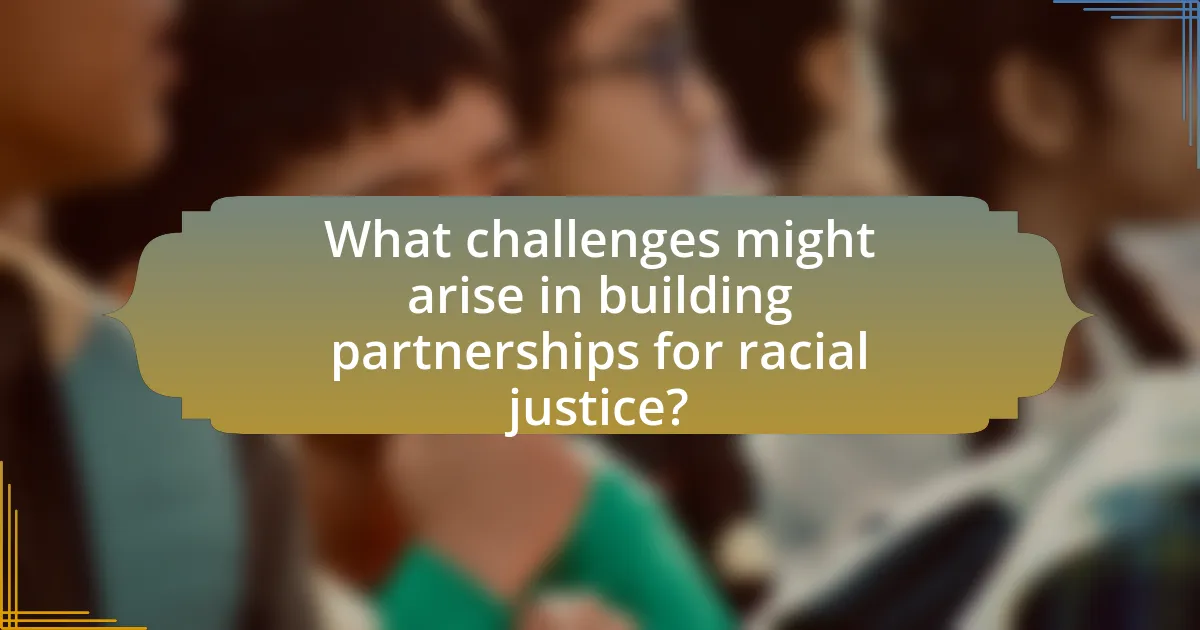
What challenges might arise in building partnerships for racial justice?
Building partnerships for racial justice may face challenges such as differing priorities among organizations, lack of trust, and resource disparities. Organizations often have varying missions and goals, which can lead to conflicts in strategy and focus. For instance, a community organization may prioritize immediate local issues, while a larger entity might focus on systemic change, creating a disconnect. Additionally, historical mistrust between communities and institutions can hinder collaboration, as past injustices may lead to skepticism about intentions. Resource disparities, including funding and manpower, can also create imbalances that complicate partnership dynamics, making it difficult for smaller organizations to engage equally. These factors collectively impede the effectiveness of collaborative efforts aimed at achieving racial justice.
How can organizations address potential conflicts in partnerships?
Organizations can address potential conflicts in partnerships by establishing clear communication channels and setting mutual expectations from the outset. Effective communication fosters transparency, allowing partners to voice concerns and resolve misunderstandings promptly. Additionally, organizations should implement conflict resolution strategies, such as mediation or negotiation, to facilitate discussions when disagreements arise. Research indicates that partnerships with defined roles and responsibilities experience fewer conflicts, as evidenced by a study published in the Journal of Community Engagement and Scholarship, which highlights the importance of clarity in collaborative efforts. By prioritizing open dialogue and structured conflict resolution, organizations can effectively manage and mitigate potential conflicts in partnerships.
What strategies can be implemented to resolve disagreements?
Effective strategies to resolve disagreements include active listening, open communication, and collaborative problem-solving. Active listening ensures that all parties feel heard and understood, which can reduce tension and foster a more constructive dialogue. Open communication encourages transparency and honesty, allowing individuals to express their perspectives without fear of retribution. Collaborative problem-solving involves working together to identify common goals and develop mutually beneficial solutions, which can strengthen relationships and build trust. Research indicates that these strategies can lead to more positive outcomes in conflict resolution, as they promote empathy and understanding among diverse groups.
How can organizations navigate power dynamics in partnerships?
Organizations can navigate power dynamics in partnerships by establishing clear communication channels and fostering mutual respect among all stakeholders. Effective communication ensures that all voices are heard, which is crucial in addressing imbalances of power. For instance, organizations can implement regular check-ins and feedback sessions to assess the partnership’s dynamics and make necessary adjustments. Research indicates that partnerships characterized by open dialogue and shared decision-making lead to more equitable outcomes, as seen in community-based initiatives aimed at racial justice. By prioritizing transparency and inclusivity, organizations can create a collaborative environment that empowers all partners and mitigates power imbalances.
What are common barriers to effective collaboration?
Common barriers to effective collaboration include communication issues, differing goals, lack of trust, and resource constraints. Communication issues arise when partners do not share information effectively, leading to misunderstandings. Differing goals can create conflict, as organizations may prioritize different outcomes. Lack of trust undermines collaboration, making it difficult for partners to rely on one another. Resource constraints, such as limited funding or personnel, hinder the ability to work together effectively. These barriers are frequently cited in studies on collaboration, such as the “Collaborative Governance: A New Approach to Building Partnerships” report by the National Academy of Public Administration, which highlights the importance of addressing these challenges to foster successful partnerships.
How can resource limitations impact partnership effectiveness?
Resource limitations can significantly hinder partnership effectiveness by restricting the availability of essential tools, funding, and personnel needed to achieve collaborative goals. When community organizations face financial constraints, they may struggle to allocate sufficient resources for outreach, program development, and capacity building, which are critical for fostering strong partnerships. For instance, a study by the National Council of Nonprofits indicates that 70% of nonprofits report that limited funding directly affects their ability to serve their communities effectively. This lack of resources can lead to diminished trust and engagement among partners, ultimately undermining the collective impact of initiatives aimed at racial justice.
What role does community engagement play in overcoming barriers?
Community engagement plays a crucial role in overcoming barriers by fostering collaboration and trust between marginalized groups and institutions. This engagement allows for the identification of specific challenges faced by these communities, enabling tailored solutions that address their unique needs. For instance, research by the Urban Institute highlights that community-driven initiatives lead to increased participation in decision-making processes, which directly impacts policy changes that benefit underrepresented populations. By actively involving community members, organizations can dismantle systemic obstacles and promote equitable access to resources and opportunities.
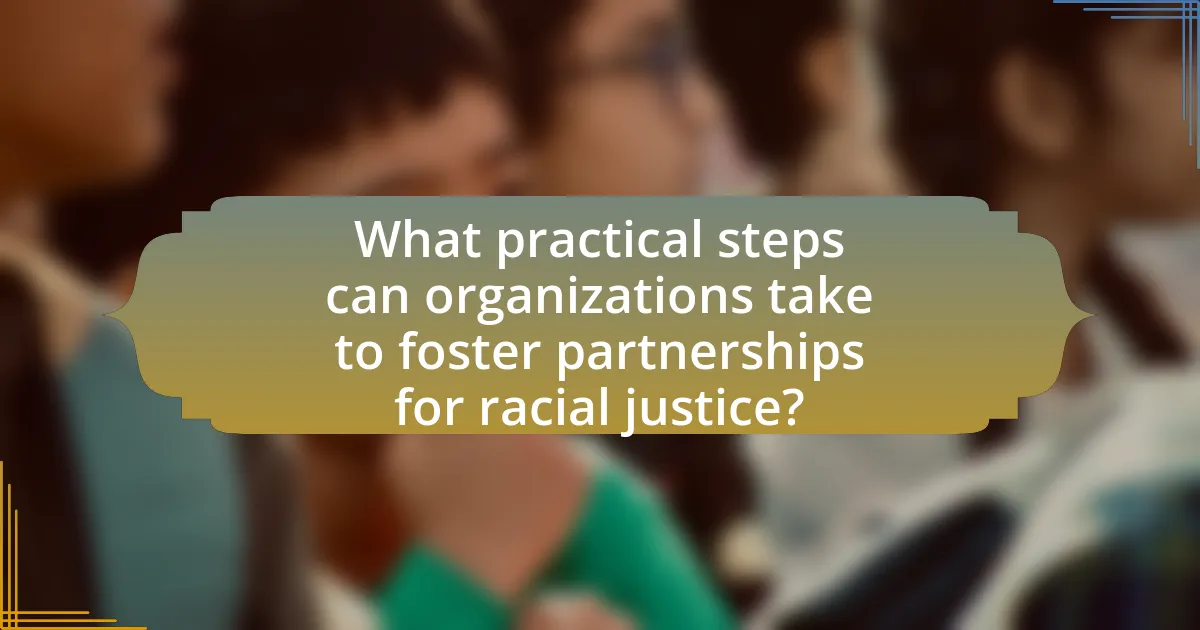
What practical steps can organizations take to foster partnerships for racial justice?
Organizations can foster partnerships for racial justice by actively engaging with community organizations, establishing clear communication channels, and committing to shared goals. Engaging with community organizations allows for the incorporation of diverse perspectives and experiences, which is essential for addressing systemic issues. Clear communication ensures that all parties understand their roles and responsibilities, fostering trust and collaboration. Additionally, committing to shared goals, such as equitable resource distribution or policy advocacy, aligns efforts and maximizes impact. Research shows that partnerships built on mutual respect and shared objectives lead to more effective outcomes in social justice initiatives, as evidenced by successful collaborations documented in studies like “The Role of Community Partnerships in Racial Justice” published by the American Journal of Community Psychology.
What best practices should organizations follow when forming partnerships?
Organizations should establish clear objectives and mutual benefits when forming partnerships. This clarity ensures that all parties understand their roles and the goals of the collaboration, which is essential for effective teamwork. Research indicates that partnerships with defined goals lead to higher success rates, as evidenced by a study published in the Journal of Community Engagement and Scholarship, which found that 75% of successful partnerships had clearly articulated objectives. Additionally, organizations should prioritize open communication and trust-building, as these elements foster a collaborative environment and enhance relationship longevity. A report by the National Council of Nonprofits highlights that transparent communication practices significantly improve partnership outcomes, with 80% of organizations noting better results when communication is prioritized. Lastly, organizations must engage in regular evaluation and feedback mechanisms to assess partnership effectiveness and make necessary adjustments, ensuring that the partnership remains aligned with its objectives and responsive to changing circumstances.
How can organizations ensure mutual benefit in partnerships?
Organizations can ensure mutual benefit in partnerships by establishing clear, shared goals and open communication from the outset. This approach fosters alignment in objectives, allowing both parties to work collaboratively towards common outcomes. Research indicates that partnerships with defined mutual benefits lead to increased trust and commitment, which are essential for long-term success. For instance, a study by the Stanford Social Innovation Review highlights that organizations that engage in co-creation processes with community partners often achieve more impactful results, as both sides contribute their unique strengths and resources.
What tools and resources are available to support partnership development?
Tools and resources available to support partnership development include collaboration platforms, funding opportunities, and training programs. Collaboration platforms like Slack and Microsoft Teams facilitate communication and project management among partners. Funding opportunities from organizations such as the Ford Foundation and the Open Society Foundations provide financial support for initiatives aimed at racial justice. Training programs offered by institutions like the National Council of Nonprofits equip organizations with skills in partnership building and community engagement. These resources enhance the capacity of organizations to form effective partnerships that advance racial justice initiatives.
How can organizations measure the impact of their partnerships?
Organizations can measure the impact of their partnerships by utilizing key performance indicators (KPIs) that align with their partnership goals. These KPIs may include metrics such as increased community engagement, changes in awareness levels regarding racial justice issues, and the number of collaborative initiatives launched. For instance, a study by the Stanford Social Innovation Review highlights that organizations can track the effectiveness of their partnerships through surveys assessing community perceptions and feedback, as well as analyzing data on participation rates in joint programs. This approach provides concrete evidence of the partnership’s influence on community outcomes and helps organizations refine their strategies for greater impact.
What metrics can be used to evaluate partnership success?
Metrics that can be used to evaluate partnership success include shared goals achievement, resource allocation efficiency, stakeholder engagement levels, and impact measurement. Shared goals achievement assesses whether the partnership meets its predefined objectives, while resource allocation efficiency evaluates how effectively resources are utilized to support the partnership’s initiatives. Stakeholder engagement levels measure the involvement and satisfaction of all parties, indicating the partnership’s collaborative strength. Impact measurement quantifies the tangible outcomes of the partnership, such as changes in community awareness or policy improvements related to racial justice. These metrics provide a comprehensive framework for assessing the effectiveness and sustainability of partnerships in this context.
How can feedback be incorporated to improve future collaborations?
Feedback can be incorporated to improve future collaborations by systematically collecting, analyzing, and implementing insights from all stakeholders involved. This process ensures that diverse perspectives are considered, leading to more effective strategies and outcomes. For instance, organizations can utilize surveys or focus groups post-collaboration to gather specific feedback on communication, decision-making, and overall satisfaction. Research indicates that organizations that actively seek and apply feedback can enhance their collaborative efforts by up to 30%, as evidenced by a study published in the Journal of Community Engagement and Scholarship, which highlights the importance of iterative learning in partnership development.
